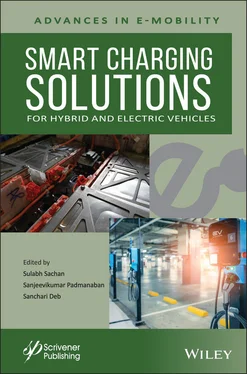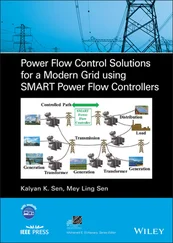Smart Charging Solutions for Hybrid and Electric Vehicles
Здесь есть возможность читать онлайн «Smart Charging Solutions for Hybrid and Electric Vehicles» — ознакомительный отрывок электронной книги совершенно бесплатно, а после прочтения отрывка купить полную версию. В некоторых случаях можно слушать аудио, скачать через торрент в формате fb2 и присутствует краткое содержание. Жанр: unrecognised, на английском языке. Описание произведения, (предисловие) а так же отзывы посетителей доступны на портале библиотеки ЛибКат.
- Название:Smart Charging Solutions for Hybrid and Electric Vehicles
- Автор:
- Жанр:
- Год:неизвестен
- ISBN:нет данных
- Рейтинг книги:4 / 5. Голосов: 1
-
Избранное:Добавить в избранное
- Отзывы:
-
Ваша оценка:
- 80
- 1
- 2
- 3
- 4
- 5
Smart Charging Solutions for Hybrid and Electric Vehicles: краткое содержание, описание и аннотация
Предлагаем к чтению аннотацию, описание, краткое содержание или предисловие (зависит от того, что написал сам автор книги «Smart Charging Solutions for Hybrid and Electric Vehicles»). Если вы не нашли необходимую информацию о книге — напишите в комментариях, мы постараемся отыскать её.
The most comprehensive and up-to-date study of smart charging solutions for hybrid and electric vehicles for engineers, scientists, students, and other professionals. Smart Charging Solutions for Hybrid and Electric Vehicles:
Smart Charging Solutions for Hybrid and Electric Vehicles — читать онлайн ознакомительный отрывок
Ниже представлен текст книги, разбитый по страницам. Система сохранения места последней прочитанной страницы, позволяет с удобством читать онлайн бесплатно книгу «Smart Charging Solutions for Hybrid and Electric Vehicles», без необходимости каждый раз заново искать на чём Вы остановились. Поставьте закладку, и сможете в любой момент перейти на страницу, на которой закончили чтение.
Интервал:
Закладка:
The developers of smart charging take the third approach. The third approach ensures that the overall system is intelligent to make decisions even when it is not able to coordinate with the connected devices or software. For example, while in operation, the cable connecting the distribution transformer and the charging station of a smart charging system experience a higher current than the normal value. As per the first approach, the information of fault will be conveyed to the operator of the monitoring station and the fault will continue until the operator signals to shut down the operation. There is a possibility that the cables will be damaged by the time operator responds, the operator did not respond due to negligence, or there was a communication breakdown leading to non-receipt of information at the operator end. If the second approach is taken, although the system will shut down due to fault, the operator will have no information to detect the cause of the fault. However, if the third approach is taken, the operator will get information about the fault and the system will shut down operation on its own. The third approach ensures the safety of the system and saves time working on fault correction.
1.1.3 Contributions
This chapter has described the types of charging followed by the categorization of smart charging, the requirements and components of the smart charging system, the enablers who coherently support the development, operation, and management of the smart charging system, and control architectures developed so far for implementation and integration with the conventional grid. They commenced an outlook on commerce, evolution, and competitiveness in the smart charging system market.
This section is structured to give readers an understanding of the term “smart” and its applicability in an EV charging infrastructure. The first section defines “smart” and explains the context and approaches to adding smartness. The second section deals with different types of charging: viz., uncoordinated, coordinated, and smart. The third and fourth sections describe the impact and requirements of the smart-charging system, respectively. The fifth section defines each smart-charging system’s components, followed by a discussion on various control architectures that can be used for smart charging in the sixth section. The commerce and outlook of smart-charging are explored in the seventh section, followed by a conclusion in the eighth section.
1.2 Types of Charging
The charging of EVs needs power from a source. The power source can be the conventional utility grid, local energy storage system, renewable energy systems, or a hybrid system developed by combining any of the sources mentioned. Apart from charging EVs, the power sources also feed load connected and cater services to increase the utility grid’s reliability. Charging EVs adds an extra load to the power sources. Three types of charging consider the management and distribution of power due to the addition of load from EV charging are widely discussed in the literature: viz., uncoordinated, coordinated, and smart [9, 10].
1.2.1 Uncoordinated Charging
The utility grid connecting to the load from a power source is designed to meet a particular region’s power demand. Further, the utility grid operators perform demand response or load distribution analysis to serve consumers with reliability. If an unprecedented load is added to the utility grid, the possibility of voltage fluctuations and blackouts increases [11]. Uncoordinated charging transpires when the EV’s charge is done in the form of unprecedented loads, i.e., the time to charge EVs is not scheduled in coordination with the utility grid [12, 13].
The impact of uncoordinated charging to the utility grid can be described in two ways: increased load demand and change in the shape of load profile. Increased load demand refers to the need for more kilowatts at a particular instant, as noted previously. In contrast, the change in shape of the load profile corresponds to a change in the timing of peak load and offpeak load hours. Literature reports that even a low adoption of EVs could significantly change the load profile and affect electricity infrastructure. The impacts of uncoordinated charging are not limited to the load demand and shape; phase imbalance, power quality issues, such as an increase in total harmonic distortion, increased power loss, line loading, and equipment degradation, such as transformers and circuit breakers, also impact the utility grid [11]. However, the impact of uncoordinated charging is seen on all three segments of the utility grid, namely, generation, transmission, and distribution systems, but the distribution section of the utility grid is the worst affected [14].
1.2.2 Coordinated Charging
Coordinated charging is characterized by charging EVs in coordination with the utility grid. The coordination is required to identify the present condition (load connected) of the grid or power source that will supply the power to charge EVs. The peak load and off-peak load hours of a utility grid vary based on residential, industrial, or commercial regions. In general, for the residential area, the utility grid is in peak load at evening and night hours, while the off-peak load hours are noted during late nights when people sleep. The load demand for an industrial area will depend on the working shifts and operation of factories. For commercial areas, the peak load hours will be at consumer visiting hours, i.e., during the evening. The off-peak load hours will be during the morning [6, 15].
In the case of coordinated charging, based on the regions, the process of charging is scheduled during off-peak load hours. However, it is ensured that EV owners are not barred from the services. The literature is flooded with works done to perform coordinated charging by developing optimizing algorithms, demand response strategy, load scheduling, controllers, dynamic pricing methodology, electricity market operation strategy, and time of use (ToU) [16-22]. Although the works in the literature are diverse, each of them shares the following common goals:
1 a. The EV owners’ need to charge at any time of the day should not be denied, irrespective of the loading in the utility grid
2 b. The power system operator (PSO) constraints should be coordinated and supported in the quest to charge EVs
3 c. Necessary support services from the EV owner to the PSO and the PSO to the EV owners should be provided via necessary coordination
4 d. Increased penetration of local energy storage and renewable energy sources in the utility grid
Coordinated charging of EVs is complicated, expensive, and needs standard infrastructure support for implementations. However, the benefits are immense compared to uncoordinated charging. Coordinated charging helps solve two major issues: first, congestion management, which is defined as an increase in thermal loading in transformers and cables and, second, voltage drops, which are most commonly experienced due to the addition of any unprecedented load, such as EVs [15, 23-25].
The type of charging is also a significant factor to be considered when working with coordinated charging [8, 11]. A fast-charging requires a higher amount of power to be transferred to the EV batteries in a short duration of time. In contrast, in slow charging, the requirement of power is reduced, but time is increased. The ToU and dynamic pricing algorithms are the most commonly presented in the literature to cater to the requirements of power for different charging types. Although coordinated charging solves the basic requirements of charging EVs in consideration to the utility grid’s constraints and managing EVs as a load, it fails to be a future proof system where both the EV owner and the PSO are guaranteed an optimized charging process [10, 18].
Читать дальшеИнтервал:
Закладка:
Похожие книги на «Smart Charging Solutions for Hybrid and Electric Vehicles»
Представляем Вашему вниманию похожие книги на «Smart Charging Solutions for Hybrid and Electric Vehicles» списком для выбора. Мы отобрали схожую по названию и смыслу литературу в надежде предоставить читателям больше вариантов отыскать новые, интересные, ещё непрочитанные произведения.
Обсуждение, отзывы о книге «Smart Charging Solutions for Hybrid and Electric Vehicles» и просто собственные мнения читателей. Оставьте ваши комментарии, напишите, что Вы думаете о произведении, его смысле или главных героях. Укажите что конкретно понравилось, а что нет, и почему Вы так считаете.












